inflation pressure Citroen C3 2017 2.G Owner's Manual
[x] Cancel search | Manufacturer: CITROEN, Model Year: 2017, Model line: C3, Model: Citroen C3 2017 2.GPages: 450, PDF Size: 10.11 MB
Page 6 of 450
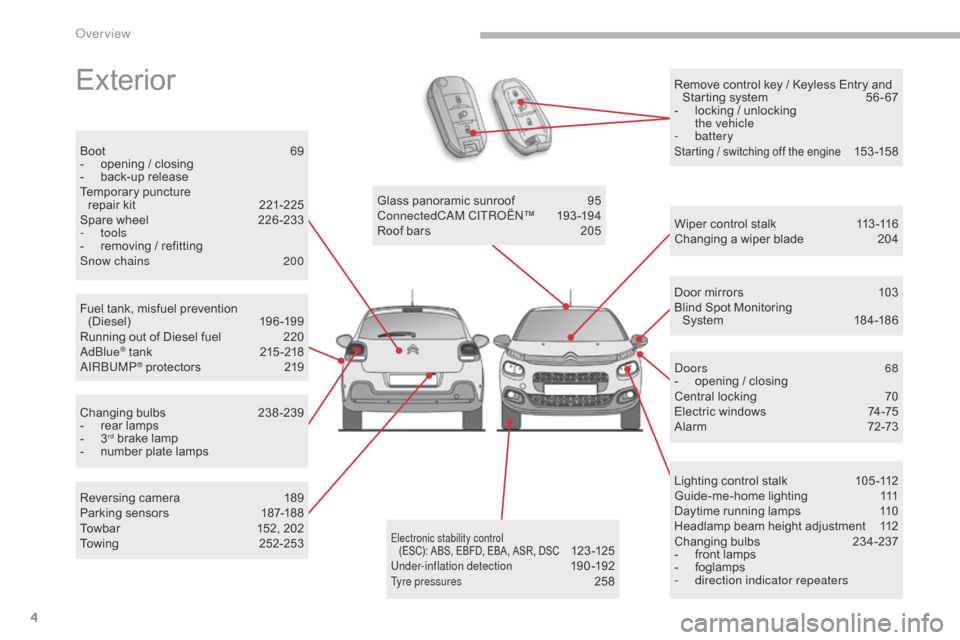
4
B618_en_Chap00b_vue-ensemble_ _ed01-2016
Remove control key / Keyless Entry and Starting system 5 6 - 67
-
l
ocking / unlocking
the vehicle
-
battery
Starting / switching off the engine 153 -15 8
Exterior
Fuel tank, misfuel prevention (Diesel) 19 6 -19 9
Running out of Diesel fuel
2
20
AdBlue
® tank 21 5 -218
AIRBUMP® protectors 2 19
Boot
6
9
-
o
pening / closing
-
b
ack-up release
Temporary puncture
repair kit
2
21-225
Spare wheel
2
26-233
-
tools
-
r
emoving / refitting
Snow chains
2
00
Changing bulbs
2
38-239
-
r
ear lamps
-
3rd brake lamp
-
n
umber plate lamps Glass panoramic sunroof
9
5
ConnectedCAM C ITROËN
™ 19
3 -19 4
Roof bars
2
05
Wiper control stalk
1
13 -116
Changing a wiper blade
2
04
Door mirrors
1
03
Blind Spot Monitoring System
18
4 -18 6
Doors 68
-
o
pening / closing
Central locking
7
0
Electric windows
7
4-75
Alarm 7 2-73
Lighting control stalk
1
05 -112
Guide-me-home lighting
1
11
Daytime running lamps
1
10
Headlamp beam height adjustment
1
12
Changing bulbs
2
34-237
-
f
ront lamps
-
fo
glamps
-
d
irection indicator repeaters
Electronic stability control (ESC): ABS, EBFD, EBA, ASR, DSC 123 -125Under-inflation detection 19 0 -192Tyre pressures 25 8
Reversing camera
1
89
Parking sensors
1
87-188
Towbar
1
52, 202
Towing
2
52-253
Over view
Page 32 of 450

30
Under-inflationfixed, accompanied by
an audible signal and
a message. The pressure in one or more tyres is
too low.
Check the tyre pressures as soon as possible.
This check should preferably be carried out when the
tyres are cold.
You must reinitialise the system after the adjustment
of one or more tyre pressures and after changing one
or more wheels.
For more information on Under-inflation detection
,
refer to the corresponding section.
+ flashing then fixed,
accompanied by the
Service warning lamp.The system has a fault: the tyre
pressures are no longer monitored.
Check the tyre pressures as soon as possible.
Have the system checked by a CITROËN dealer or a
qualified workshop.
Foot on the
brake fixed.
The brake pedal is not pressed
sufficiently. With an automatic gearbox, with the engine running,
press the brake pedal before releasing the parking
brake, to unlock the lever and come out of position P
.
If you wish to release the parking brake without
pressing the brake pedal, this warning lamp will
remain on.
Warning / indicator lamp
StateCause Action / Observations
Instruments
Page 42 of 450
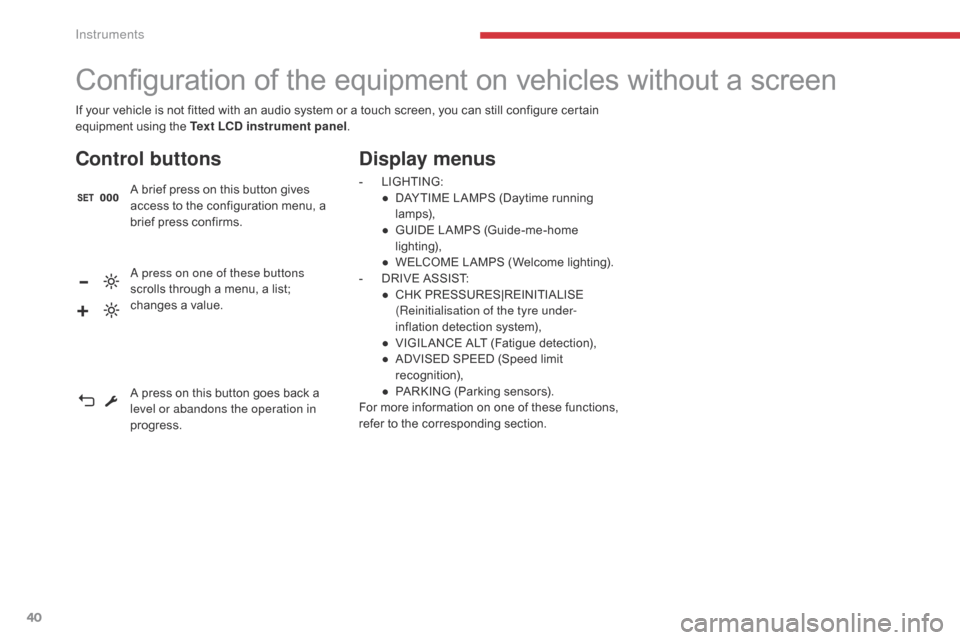
40
If your vehicle is not fitted with an audio system or a touch screen, you can still configure certain
equipment using the Text LCD instrument panel.
Configuration of the equipment on vehicles without a screen
Control buttons
A brief press on this button gives
access to the configuration menu, a
brief press confirms.
Display menus
- LIGHTING:
● D AYTIME LAMPS (Daytime running
lamps),
●
G
UIDE LAMPS (Guide-me-home
lighting),
●
W
ELCOME LAMPS (Welcome lighting).
-
D
RIVE ASSIST:
●
C
HK PRESSURES|REINITIALISE
(Reinitialisation of the tyre under-
inflation detection system),
●
V
IGILANCE ALT (Fatigue detection),
●
A
DVISED SPEED (Speed limit
recognition),
●
P
ARKING (Parking sensors).
For more information on one of these functions,
refer to the corresponding section.
A press on one of these buttons
scrolls through a menu, a list;
changes a value.
A press on this button goes back a
level or abandons the operation in
progress.
Instruments
Page 192 of 450
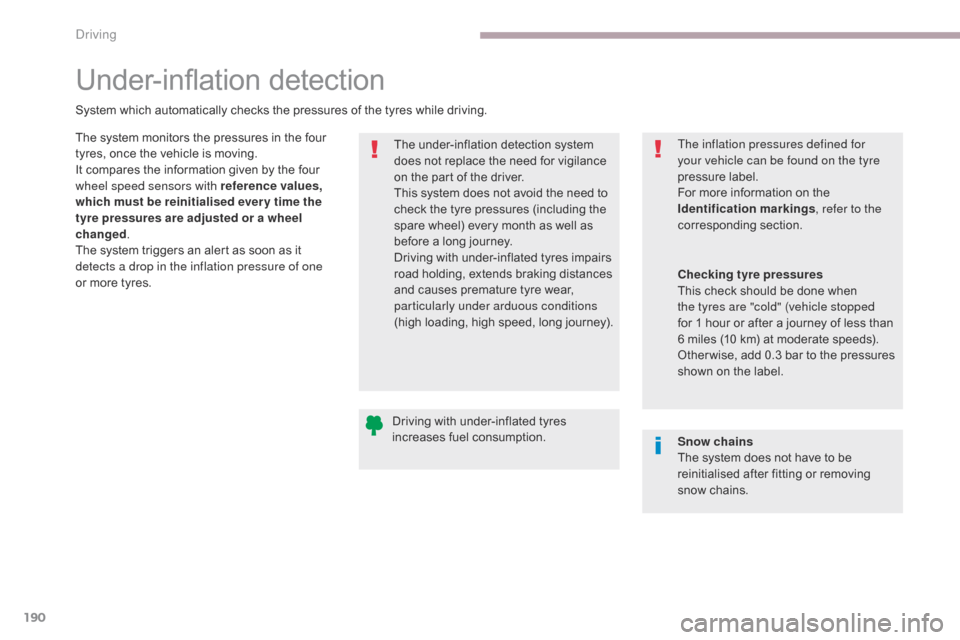
190
B618_en_Chap06_conduite_ed01-2016
Driving with under-inflated tyres
increases fuel consumption.The under-inflation detection system
does not replace the need for vigilance
on the part of the driver.
This system does not avoid the need to
check the tyre pressures (including the
spare wheel) every month as well as
before a long journey.
Driving with under-inflated tyres impairs
road holding, extends braking distances
and causes premature tyre wear,
particularly under arduous conditions
(high loading, high speed, long journey).
The inflation pressures defined for
your vehicle can be found on the tyre
pressure label.
For more information on the
Identification markings
, refer to the
corresponding section.
Snow chains
The system does not have to be
reinitialised after fitting or removing
snow chains.
Under-inflation detection
System which automatically checks the pressures of the tyres while driving.
The system monitors the pressures in the four
tyres, once the vehicle is moving.
It compares the information given by the four
wheel speed sensors with reference values,
which must be reinitialised ever y time the
tyre pressures are adjusted or a wheel
changed .
The system triggers an alert as soon as it
detects a drop in the inflation pressure of one
or more tyres. Checking tyre pressures
This check should be done when
the
tyres are "cold" (vehicle stopped
for
1 hour or after a journey of less than
6 miles (10 km) at moderate speeds).
Other wise, add 0.3 bar to the pressures
shown on the label.
Driving
Page 193 of 450

191
B618_en_Chap06_conduite_ed01-2016
Under-inflation alertReinitialisation
Before reinitialising the system, ensure
that the pressures of the four tyres are
correct for the use of the vehicle and in
line with the recommendations on the
tyre pressure label.
The under-inflation alert can only
be relied on if the reinitialisation of
the system has been done with the
pressures in the four tyres correctly
adjusted.
The under-inflation detection system
does not give a warning if a pressure is
incorrect at the time of reinitialisation.
This is given by fixed illumination of
this warning lamp, accompanied by
an audible signal and, depending on
equipment, the display of a message.
It is necessary to reinitialise the system every
time one or more tyre pressures are adjusted,
and after changing one or more wheels.
F
R
educe speed immediately, avoid
excessive steering movements and sudden
braking.
F
S
top the vehicle as soon as it is safe to
do
so. F
I
f you have a compressor, such as the one
in the temporary puncture repair kit, check
the pressures of the four tyres when cold.
F
I
f it is not possible to make this check
immediately, drive carefully at reduced
speed.
or
F
I
n the event of a puncture, use the
temporary puncture repair kit or the spare
wheel (depending on equipment).
The loss of pressure detected does not
always cause visible bulging of the tyre.
Do not satisfy yourself with just a visual
check. The alert is maintained until the system
is reinitialised.
6
Driving
Page 194 of 450
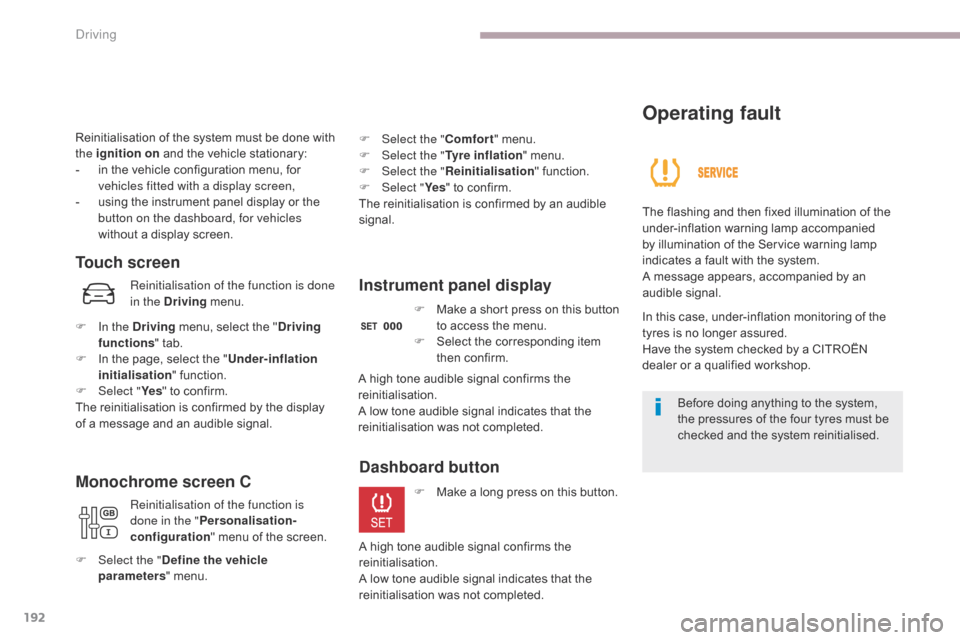
192
B618_en_Chap06_conduite_ed01-2016
Reinitialisation of the system must be done with
the ignition on and the vehicle stationary:
-
i
n the vehicle configuration menu, for
vehicles fitted with a display screen,
-
u
sing the instrument panel display or the
button on the dashboard, for vehicles
without a display screen.
Touch screen
Monochrome screen C
Operating fault
The flashing and then fixed illumination of the
under-inflation warning lamp accompanied
by illumination of the Service warning lamp
indicates a fault with the system.
A message appears, accompanied by an
audible signal.
In this case, under-inflation monitoring of the
tyres is no longer assured.
Have the system checked by a CITROËN
dealer or a qualified workshop.
Before doing anything to the system,
the pressures of the four tyres must be
checked and the system reinitialised.
Instrument panel displayReinitialisation of the function is done
in the Driving menu.
F
I
n the Driving menu, select the " Driving
functions " tab.
F
I
n the page, select the " Under-inflation
initialisation " function.
F
Sel
ect " Ye s" to confirm.
The reinitialisation is confirmed by the display
of a message and an audible signal.
Reinitialisation of the function is
done in the " Personalisation-
configuration " menu of the screen.
F
Sel
ect the " Define the vehicle
parameters " menu. F
M
ake a short press on this button
to access the menu.
F
S
elect the corresponding item
then confirm.
A high tone audible signal confirms the
reinitialisation.
A low tone audible signal indicates that the
reinitialisation was not completed.
Dashboard button
F Make a long press on this button.
A high tone audible signal confirms the
reinitialisation.
A low tone audible signal indicates that the
reinitialisation was not completed. F
Sel
ect the "
Comfort " menu.
F
Sel
ect the "
Tyre inflation " menu.
F
Sel
ect the "
Reinitialisation " function.
F
Sel
ect "
Ye s" to confirm.
The reinitialisation is confirmed by an audible
signal.
Driving
Page 223 of 450
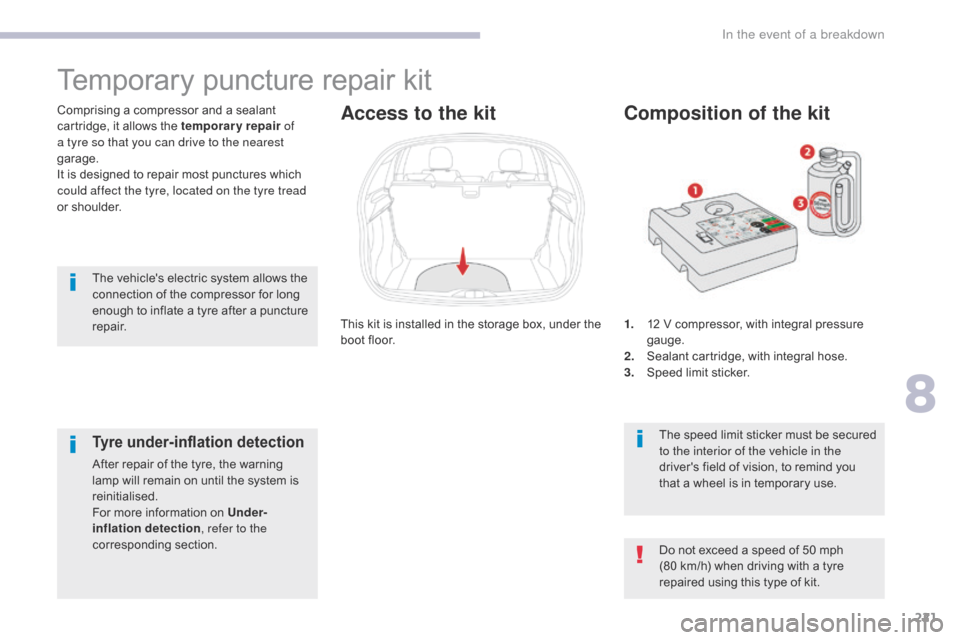
221
B618_en_Chap08_En-cas-de-panne_ed01-2016
1. 12 V compressor, with integral pressure gauge.
2.
S
ealant cartridge, with integral hose.
3.
S
peed limit sticker.
Composition of the kit
The speed limit sticker must be secured
to the interior of the vehicle in the
driver's field of vision, to remind you
that a wheel is in temporary use.
The vehicle's electric system allows the
connection of the compressor for long
enough to inflate a tyre after a puncture
repair.
This kit is installed in the storage box, under the
boot floor.
Comprising a compressor and a sealant
cartridge, it allows the temporary repair
of
a tyre so that you can drive to the nearest
garage.
It is designed to repair most punctures which
could affect the tyre, located on the tyre tread
or shoulder.
Temporary puncture repair kit
Access to the kit
Do not exceed a speed of 50 mph
(80 km/h) when driving with a tyre
repaired using this type of kit.
Tyre under-inflation detection
After repair of the tyre, the warning
lamp will remain on until the system is
reinitialised.
For more information on Under-
inflation detection , refer to the
corresponding section.
8
In the event of a breakdown
Page 227 of 450

225
B618_en_Chap08_En-cas-de-panne_ed01-2016
Should the pressure of one or more
tyres be adjusted, it is necessary to
reinitialise the under-inflation detection
system.
For more information on Under-
inflation detection, refer to the
corresponding section.
F
S
tart the compressor by placing the switch
at the " I" position and adjust the pressure
to the value shown on the vehicle's tyre
pressure label.
T
o deflate: press the black button on the
compressor pipe, at the valve connector.
F
O
nce the correct pressure is reached, put
the switch to the " O" position.
F
R
emove the kit then stow it.
8
In the event of a breakdown
Page 260 of 450
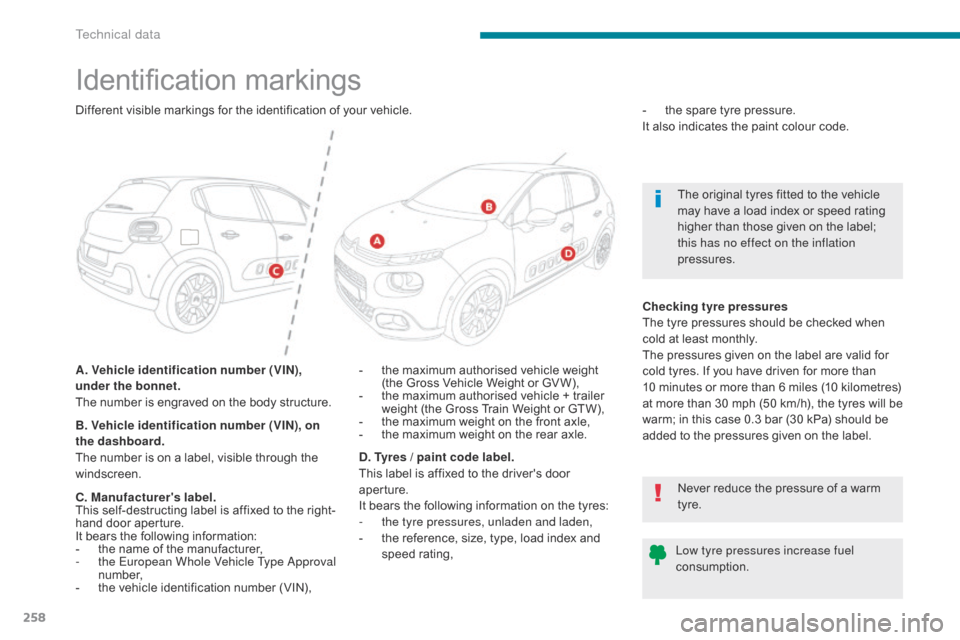
258
B618_en_Chap09_caracteristiques-techniques_ed01-2016
Identification markings
A. Vehicle identification number (VIN),
under the bonnet.
The number is engraved on the body structure.-
t he maximum authorised vehicle weight
(the Gross Vehicle Weight or GV W),
-
t
he maximum authorised vehicle + trailer
weight (the Gross Train Weight or GTW),
-
t
he maximum weight on the front axle,
-
t
he maximum weight on the rear axle.-
t
he spare tyre pressure.
It also indicates the paint colour code.
B. Vehicle identification number (VIN), on
the dashboard.
The number is on a label, visible through the
windscreen. Checking tyre pressures
The tyre pressures should be checked when
cold at least monthly.
The pressures given on the label are valid for
cold tyres. If you have driven for more than
10
minutes or more than 6 miles (10 kilometres)
at more than 30 mph (50 km/h), the tyres will be
warm; in this case 0.3 bar (30 kPa) should be
added to the pressures given on the label.
Different visible markings for the identification of your vehicle.
Low tyre pressures increase fuel
consumption.Never reduce the pressure of a warm
tyre. The original tyres fitted to the vehicle
may have a load index or speed rating
higher than those given on the label;
this has no effect on the inflation
pressures.
C. Manufacturer's label.
This self-destructing label is affixed to the right-
hand door aperture.
It bears the following information:
-
t
he name of the manufacturer,
-
t
he European Whole Vehicle Type Approval
number,
-
t
he vehicle identification number (VIN), D. Tyres / paint code label.
This label is affixed to the driver's door
aperture.
It bears the following information on the tyres:
-
t
he tyre pressures, unladen and laden,
-
t
he reference, size, type, load index and
speed rating,
Technical data
Page 264 of 450

262
B618_en_Chap11_index-alpha_ed01-2016
Maintenance (advice) ....................................2 19
Maintenance, routine ........................................ 9
M
ap reading lamps
......................................... 94
M
arkings, identification
................................. 25
8
Mat
.......
.....................................................96, 99
Memorising a speed
..................................... 17
0
Mirror, rear view
............................................ 10
4
Mirrors, door ..........................................103, 184
Misfuel prevention
...............................
..........198
Mountings, Isofix
...............................
............143
Oil change
...............................
......................209
Oil consumption
............................................ 20
9
OIl, engine
...............................
......................209
Opening the bonnet
...................................... 20
6
Opening the boot
..............................
.. 57, 59, 69
Opening the doors
.............................. 5
7, 59, 68Pads, brake ...................................................
2
14
Paint colour code
..........................................25
8
Panoramic glass sunroof
................................95
P
arcel shelf, rear
...................................10
1, 102
Parking brake
.................................. 1
7, 159, 214
Parking sensors, rear.................................... 187
Plates, identification ...................................... 258
Port, USB
..................................................9
6, 98
Pre-heater, Diesel
...............................
............17
Pressures, tyres
....................................2
25, 258
Pre-tensioning seat belts
..............................12
8
Priming the fuel system
................................2
20
Protecting children
........................13
0, 13 4 -13 6,
141, 143 -145, 147
Protectors
...................................................... 2
19
Puncture
................
........................................221
M
O
P
Number plate lamps ......................................23 9
N
L
Range, AdBlue ..........................................26, 36
Rear screen, demisting ................................... 93
R
echarging the battery
.................................25
0
Recirculation, air
...............................
........86, 88
Reduction of electrical load
.......................... 20
3
Regeneration of the particle filter
.................2
13
Reinitialisation of the under-inflation detection system
................................. 19
1, 192
Reinitialising the remote control
.....................67
R
eminder, key in ignition
...............................15
5
Reminder, lighting on
.................................... 10
8
Remote control
........................ 5
6, 57, 59 - 61, 63
Removing a wheel
..............................
..........229
R
Labels, identification ..................................... 25 8
Lamp, boot ............................... ...............95, 240
Lamps, parking
............................................. 11
0
Lane Departure Warning System (LDWS)
...18
3
LEDs - Light-emitting diodes
........................11
0
Level, AdBlue
................................................ 2
12
Level, brake fluid
........................................... 2
10
Level, Diesel additive
.................................... 2
12
Level, engine coolant
.............................. 3
1, 211
Level, engine oil
...............................
.......35, 209
Levels and checks
..............................
...2 07-212
Level, screenwash fluid
................................2
11
Light-emitting diodes - LEDs
................11
0 , 2 4 0
Lighting
................
............................................ 16
Lighting, guide-me home
..............................111
L
ighting, interior
.............................................. 94
L
ighting, welcome
......................................... 111
Lo
ading
..............................
............................... 9
Load reduction mode
.................................... 20
3
Localised Assistance Call
..................... 1
19, 121
Locating your vehicle
...................................... 58
Lo
cking
...................................................... 5
7, 63
Locking from the inside
...................................70
L
ow fuel level
..............................
..................19 6
Alphabetical index